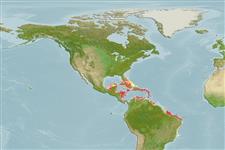Teleostei (teleosts) >
Gobiiformes (Gobies) >
Gobiidae (Gobies) > Gobiinae
Etymology: Microgobius: Greek, mikros = small + Latin, gobius = gudgeon (Ref. 45335).
More on author: Poey.
Environment: milieu / climate zone / depth range / distribution range
Ecology
Marine; demersal; depth range 0 - 36 m (Ref. 92840). Tropical
Western Central Atlantic: Caribbean Sea to Colombia and Venezuela.
Size / Weight / Age
Maturity: Lm ? range ? - ? cm
Max length : 6.0 cm TL male/unsexed; (Ref. 13628)
Dorsal spines (total): 8; Dorsal soft rays (total): 18 - 19; Anal spines: 1; Anal soft rays: 18 - 20. Distinguished by the following characteristics: general body color is light grey-brown, typically have areas of very bright iridescent blue and/or yellow; body is laterally compressed; large, nearly vertical mouth; completely scaled body; first dorsal with VII spines; ventral fins are united (Ref. 92840).
Found on shallow, muddy or sandy bottoms, near islands . Takes refuge in holes. Does not appear to reach 6.5 cm TL.
Life cycle and mating behavior
Maturity | Reproduction | Spawning | Eggs | Fecundity | Larvae
Benthic spawner.
Cervigón, F., 1994. Los peces marinos de Venezuela. Volume 3. Fundación Científica Los Roques, Caracas,Venezuela. 295 p. (Ref. 13628)
IUCN Red List Status (Ref. 130435: Version 2024-1)
Threat to humans
Harmless
Human uses
Tools
Special reports
Download XML
Internet sources
Estimates based on models
Preferred temperature (Ref.
123201): 27 - 28.2, mean 27.6 °C (based on 446 cells).
Phylogenetic diversity index (Ref.
82804): PD
50 = 0.5000 [Uniqueness, from 0.5 = low to 2.0 = high].
Bayesian length-weight: a=0.00724 (0.00339 - 0.01546), b=3.10 (2.92 - 3.28), in cm total length, based on LWR estimates for this (Sub)family-body shape (Ref.
93245).
Trophic level (Ref.
69278): 3.2 ±0.3 se; based on size and trophs of closest relatives
Resilience (Ref.
120179): High, minimum population doubling time less than 15 months (Preliminary K or Fecundity.).
Fishing Vulnerability (Ref.
59153): Low vulnerability (10 of 100).
